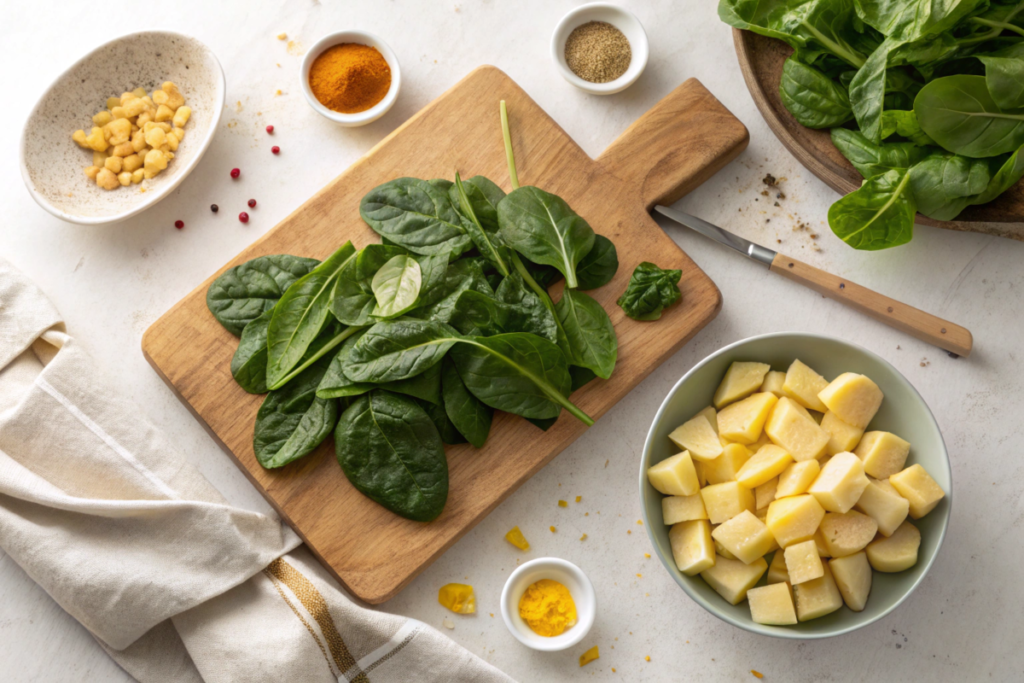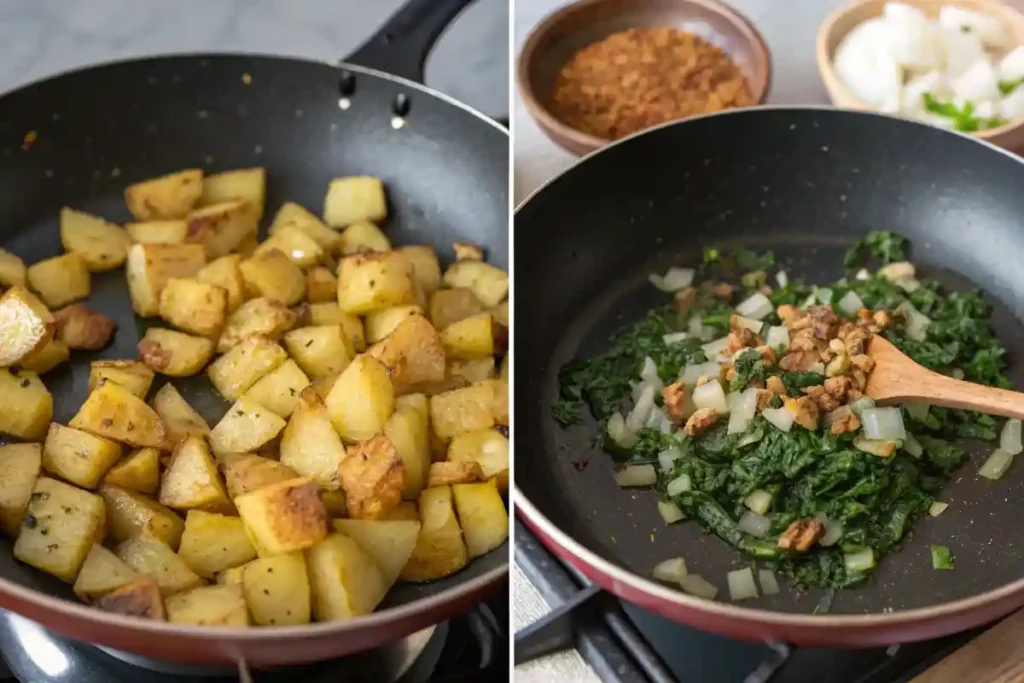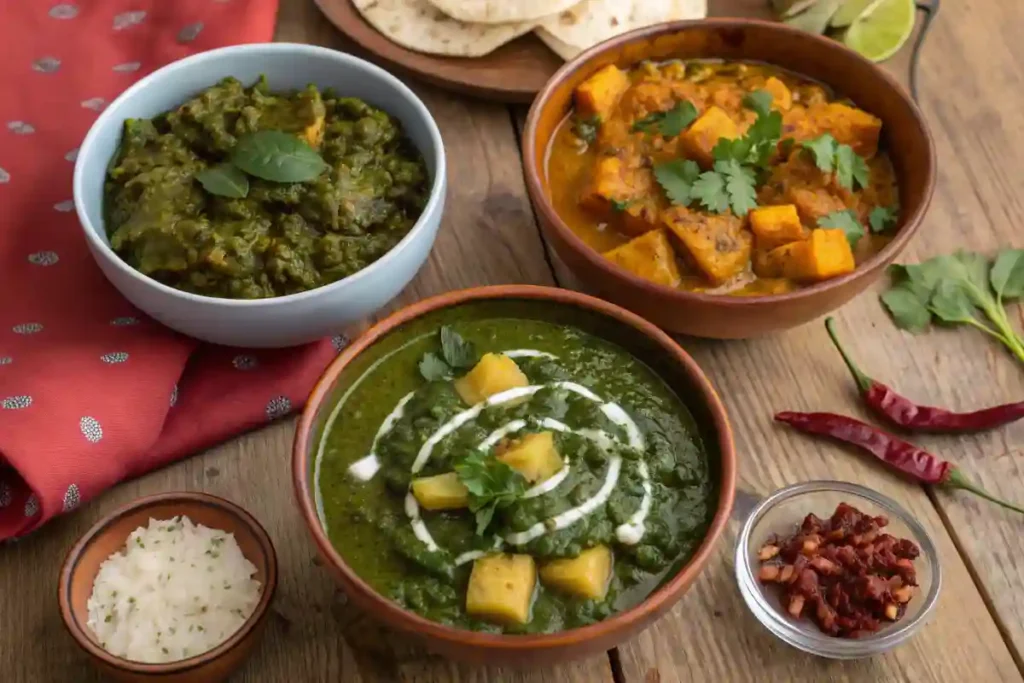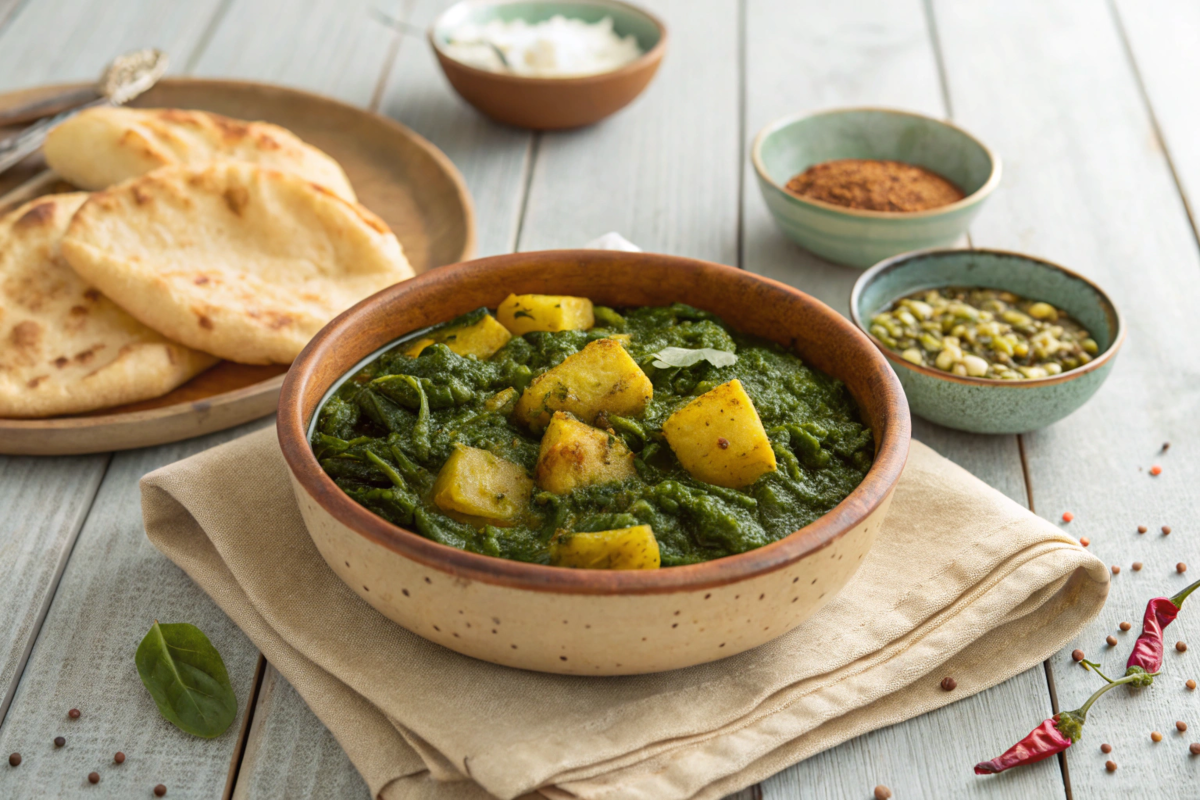Introduction to Saag Aloo
What Is Saag Aloo?
Saag Aloo is a delicious and versatile dish from Indian cuisine that combines two everyday ingredients—potatoes (aloo) and leafy greens (saag). But don’t let its simplicity fool you! This dish is bursting with flavor thanks to a medley of spices and aromatics that bring everything together. It’s hearty, comforting, and adaptable to almost any diet.
Often referred to as spinach and potato curry in Western kitchens, Saag Aloo is a vegetarian favorite that’s celebrated for its earthy taste and nourishing ingredients. It pairs wonderfully with rice, flatbreads like naan, or even as a filling for wraps. This dish has become a staple in Indian restaurants worldwide, loved for its balance of spices, creamy texture, and vibrant colors.
The Origins of Saag Aloo
The roots of Saag Aloo can be traced to North India, where “saag” is used as a generic term for leafy greens such as spinach, mustard greens, or even fenugreek leaves. The “aloo” adds heartiness to the dish, making it filling and satisfying without the need for meat or heavy creams.
Historically, this dish was a reflection of India’s agricultural abundance. Farmers would use whatever greens were in season, pairing them with the ever-reliable potato to create a dish that was not only flavorful but also packed with nutrients. Over time, Saag Aloo has become a symbol of comfort food in Indian households, passed down through generations.
Key Ingredients in Saag Aloo
Potatoes: The ‘Aloo’ Component
Potatoes form the heart of Saag Aloo, lending the dish its signature texture and comforting appeal. These starchy gems not only provide structure but also act as a sponge, absorbing the vibrant flavors of the spices and greens. Choosing the right type of potato is crucial to getting the perfect balance of softness and firmness.

Yukon Gold potatoes, for instance, are an excellent choice due to their buttery texture and ability to hold their shape during cooking. Similarly, Maris Piper potatoes, often used in Indian kitchens, offer a fluffy interior that contrasts beautifully with the crisp edges achieved when sautéed.
Potatoes are also the element that balances the earthy tones of the greens. Their mild flavor creates a neutral backdrop, allowing the bold spices and aromatics to shine. Whether you’re using diced chunks or smaller pieces for faster cooking, potatoes bring a wholesome, filling quality that makes Saag Aloo both satisfying and versatile.
Leafy Greens: The ‘Saag’ Element
The leafy greens—or saag—in Saag Aloo are what give the dish its unique identity. Traditionally, spinach is the most common choice due to its widespread availability and mild, slightly sweet flavor. However, the beauty of Saag Aloo lies in its adaptability, and you can easily substitute or combine other greens like mustard greens, fenugreek leaves, or even kale for a more complex flavor profile.
Each type of green adds its own twist. Mustard greens, for example, have a bold, peppery taste, while fenugreek leaves impart a hint of bitterness that beautifully complements the spices. Spinach, on the other hand, blends seamlessly into the dish, creating a smooth texture when cooked.
Beyond flavor, greens are packed with nutrients like iron, vitamin A, vitamin C, and antioxidants. These elements not only make Saag Aloo a flavorful dish but also a highly nutritious one. The greens contribute a vibrant green hue that makes the dish visually appealing and appetizing, while their soft, wilted texture contrasts nicely with the potatoes.
Essential Spices and Aromatics
The flavor profile of Saag Aloo is brought to life by a combination of traditional Indian spices and aromatics. At the core is turmeric, which not only adds a warm, golden color but also brings subtle earthiness. Cumin and coriander are other foundational spices, providing depth and a hint of citrusy brightness. Together, they create the base flavor that defines Saag Aloo.
Garam masala, a blend of spices often added towards the end of cooking, is the secret to enhancing the dish’s complexity. Its warming notes of cinnamon, cloves, and cardamom elevate the overall taste, making every bite memorable. For a bit of heat, red chili powder or green chilies can be used, though the level of spice is always adjustable to your preference.
Equally important are the aromatics. Garlic and ginger form a fragrant base when sautéed, their bold flavors infusing the oil before the greens and potatoes are added. Onions provide sweetness and body, mellowing out the heat from the spices. When these ingredients are properly layered, they create a harmonious medley of flavors that make Saag Aloo a true standout in Indian cuisine.
Nutritional Benefits of Saag Aloo
Saag Aloo isn’t just a flavor-packed dish; it’s also a powerhouse of nutrition. This humble combination of leafy greens and potatoes delivers a remarkable array of health benefits, making it an excellent choice for anyone seeking a wholesome meal.
First, the leafy greens—whether spinach, mustard greens, or fenugreek—are brimming with essential nutrients like vitamins A, C, and K. These vitamins support everything from strong bones to a healthy immune system, while their iron and folate content makes them particularly beneficial for individuals with anemia or during pregnancy. The greens are also loaded with antioxidants, which help fight free radicals and reduce inflammation in the body.
Potatoes, often underrated, contribute a generous dose of fiber, particularly when the skins are left intact. Fiber is crucial for digestive health, and it helps maintain steady blood sugar levels. Potatoes are also a great source of potassium, which supports heart health and regulates blood pressure.
One of the standout features of Saag Aloo is its natural alignment with dietary preferences. It’s naturally vegan and gluten-free, catering to a wide range of dietary needs. Despite its hearty texture and rich flavors, Saag Aloo is relatively low in calories, making it an excellent choice for weight management.
When you consider the combination of fiber, vitamins, minerals, and antioxidants packed into every bite, Saag Aloo becomes more than just a delicious dish—it’s a nutrient-dense option that fuels your body and satisfies your taste buds.
Traditional Preparation Methods

Making authentic Saag Aloo involves simple yet meticulous steps to bring out its vibrant flavors and perfect textures. From prepping the potatoes to cooking the greens and blending the spices, each stage plays a crucial role in crafting this iconic dish.
Preparing the Potatoes
The first step in creating Saag Aloo is to prepare the potatoes, the hearty base of the dish. Start by selecting starchy or all-purpose varieties like Yukon Gold or Maris Piper, which hold their shape well during cooking. Peel the potatoes to remove the skin unless you prefer a rustic touch, in which case, a thorough wash will suffice.
Dice the potatoes into even-sized chunks—about one inch—to ensure uniform cooking. Bring a pot of salted water to a boil and add the potatoes. Parboil them for approximately 8–10 minutes or until they’re tender but still firm. The key here is not to overcook; you want the potatoes to maintain their structure as they’ll continue cooking with the greens later.
After boiling, drain the potatoes and let them cool slightly. For an extra layer of texture, you can lightly pan-fry the parboiled potatoes in a drizzle of oil until their edges turn golden. This step adds a subtle crispness that contrasts beautifully with the soft greens.
Cooking the Leafy Greens
The saag element in Saag Aloo requires equal care to preserve its flavor, nutrients, and vibrant color. Traditionally, spinach is the most common choice, but other greens like mustard leaves or fenugreek can be included for variety.
Begin by thoroughly washing the greens to remove dirt and grit. If you’re using spinach, remove any tough stems for a smoother texture. For a quick and easy method, blanch the greens in boiling water for 1–2 minutes, then immediately transfer them to an ice bath. This process locks in their bright green hue while softening the leaves.
Alternatively, you can sauté the greens in a bit of oil with a pinch of salt to draw out their moisture. Add minced garlic or ginger during this step to infuse the greens with extra flavor. Whether blanched or sautéed, chop the greens finely once they’re cooked to ensure they blend seamlessly with the potatoes later.
Combining Ingredients with Spices
The final step in preparing Saag Aloo is all about bringing the ingredients together with a medley of aromatic spices. Start by heating oil or ghee in a deep pan. Add cumin seeds and let them sizzle until aromatic, followed by finely chopped onions. Sauté the onions until golden brown, then stir in minced garlic and ginger for a robust base.
Once the aromatics are ready, incorporate ground spices like turmeric, coriander, and a hint of red chili powder for heat. Cook the spices briefly to release their full aroma, being careful not to burn them.
Next, add the prepared potatoes, tossing them gently to coat each piece in the flavorful spice mixture. Once evenly coated, introduce the chopped greens and mix thoroughly. Cover the pan and let the dish simmer for a few minutes, allowing the flavors to meld together.
Finish with a sprinkle of garam masala for a warm, complex finish. Adjust the seasoning with salt and pepper, and garnish with fresh cilantro before serving. The result is a harmonious blend of tender potatoes, creamy greens, and bold spices—a true celebration of Indian comfort food.
Regional Variations of Saag Aloo

Saag Aloo, while rooted in North Indian cuisine, has seen numerous adaptations across regions and cultures. Each variation brings its own unique twist, adding depth and versatility to this classic dish.
North Indian Style
The North Indian version of Saag Aloo stays true to its origins, often using mustard greens (sarson) instead of spinach. These greens impart a bold, peppery flavor, which pairs beautifully with the richness of ghee—a clarified butter commonly used in Indian cooking. This style typically includes a blend of traditional spices like turmeric, cumin, and coriander, along with a finishing touch of garam masala to enhance the complexity of flavors.
In North Indian households, Saag Aloo is cooked slowly, allowing the greens to break down into a creamy consistency. The addition of a small amount of cornmeal or gram flour is common, helping to thicken the dish while adding an earthy undertone. Served hot with makki di roti (cornbread), this robust version is a winter favorite, loved for its warming and satisfying qualities.
South Indian Twist
In South India, Saag Aloo takes on a lighter, aromatic profile. Coconut milk is often incorporated, giving the dish a creamy, slightly sweet flavor that balances the spices. The base spices are distinct, featuring mustard seeds, curry leaves, and a hint of asafoetida for a unique depth.
The greens used in this variation can include amaranth leaves or drumstick leaves, offering a more regional flair. Instead of ghee, coconut oil is the preferred cooking medium, adding to the dish’s tropical vibe. A touch of tamarind or lemon juice is sometimes added to brighten the flavors, making this version lighter and perfect for pairing with steamed rice or dosa.
Western Adaptations
Western interpretations of Saag Aloo embrace creativity while maintaining the essence of the dish. Common substitutions include kale or Swiss chard in place of spinach, offering a slightly more bitter and hearty flavor. These greens, popular in Western diets, are often combined with sweet potatoes instead of regular potatoes for a healthier, nutrient-rich alternative.
Another creative adaptation involves baking Saag Aloo in a casserole dish with a breadcrumb topping. This method gives the dish a crispy layer, making it suitable for potlucks or as a vegetarian main course. Some Western versions also include mild spices, like smoked paprika, to cater to different palates while still delivering a touch of warmth and complexity.
Serving Suggestions for Saag Aloo
Saag Aloo is a versatile dish that pairs beautifully with a variety of sides, making it a favorite in Indian meals. For a classic experience, serve it with freshly made naan or roti. These soft flatbreads are perfect for scooping up the creamy greens and tender potatoes, enhancing the overall dining experience.
For a more substantial meal, pair Saag Aloo with fragrant basmati rice. The rice absorbs the spices and juices from the dish, creating a harmonious blend of textures and flavors. It also works well as part of an Indian thali—a platter featuring a mix of dishes, including lentils, pickles, and yogurt.
Yogurt-based sides like raita or plain curd add a cooling element that complements the spices in Saag Aloo. Alternatively, it can be enjoyed as a standalone meal for a light yet satisfying option, perfect for lunch or dinner. No matter how you serve it, Saag Aloo always brings warmth and flavor to the table.
Common Mistakes to Avoid
Making Saag Aloo may seem straightforward, but a few common mistakes can lead to less-than-perfect results. Overcooking the greens is one of the biggest pitfalls. When greens are cooked too long, they lose their vibrant color and fresh flavor, turning mushy and unappetizing. To prevent this, cook them just until wilted or tender.
Another issue is under-seasoning. Saag Aloo relies heavily on its spices to deliver bold flavors, so skimping on them can result in a bland dish. Always taste as you go, adjusting salt and spices to your liking.
Overcrowding the pan is another mistake to watch out for. When too many ingredients are packed together, they steam instead of sautéing, leading to a soggy texture. Use a large pan or cook in batches to ensure everything cooks evenly.
To achieve the best results, use fresh greens and high-quality spices. These elevate the dish, giving it a rich, aromatic profile. Lastly, avoid rushing the process—Saag Aloo thrives on slow, careful cooking to let the flavors meld beautifully.
Frequently Asked Questions
What is the difference between Saag Aloo and Palak Aloo?
While Saag Aloo can feature a variety of leafy greens, such as mustard greens or fenugreek, Palak Aloo specifically uses spinach (palak). Spinach gives the dish a milder, slightly sweeter flavor compared to the more robust taste of mustard or fenugreek greens. This makes Palak Aloo ideal for those new to Indian cuisine or seeking a gentler flavor profile.
Can I use other greens besides spinach?
Absolutely! Saag Aloo is incredibly versatile. Mustard greens add a bold, peppery kick, while fenugreek leaves contribute a hint of bitterness. Kale is another great alternative, offering a hearty texture and a slightly earthy taste. You can even combine different greens for a more complex flavor. Just ensure the greens you choose are fresh for the best results.
How do I store and reheat leftovers?
To store Saag Aloo, allow it to cool completely before transferring it to an airtight container. It will keep well in the refrigerator for up to three days. For reheating, use a stovetop pan on low heat. Add a splash of water or broth to prevent it from drying out. Avoid using the microwave, as it can make the potatoes soggy and the greens lose their texture.
Conclusion
Saag Aloo is more than just a dish—it’s a celebration of simple, wholesome ingredients elevated by vibrant spices. Its versatility makes it suitable for a variety of diets, from vegan to gluten-free, and its rich history ties it to the heart of Indian culinary traditions.
Whether you prefer the bold flavors of mustard greens or the mild sweetness of spinach, Saag Aloo offers endless possibilities to explore. Try regional variations, experiment with spices, or even create your own twist on this timeless recipe.
By bringing together nutrition, flavor, and culture, Saag Aloo remains a must-try for anyone looking to dive into the world of Indian cuisine. Ready to make it? Grab your potatoes and greens, and start cooking!

